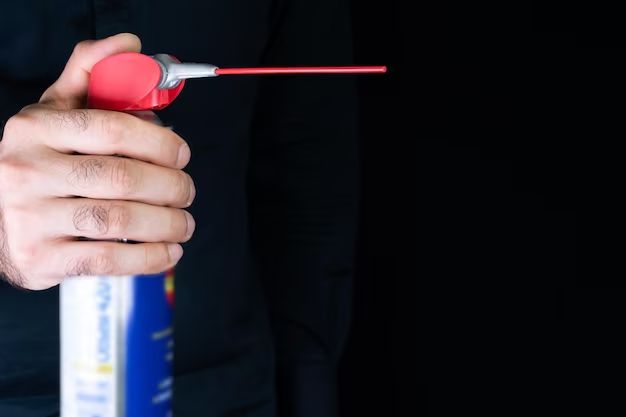Rust is an oxidization process that occurs when iron or iron alloys are exposed to oxygen and moisture. This chemical reaction results in the formation of rust, which is hydrated iron oxide. While rust can occur naturally over time, there are also sprays and chemicals that can rapidly accelerate rusting on metal surfaces.
Page Contents
What Causes Rust?
Rust formation requires three ingredients – iron, oxygen, and water. Iron on its own is relatively stable. However, when iron is exposed to oxygen from the atmosphere, it undergoes oxidation, forming iron oxide. This chemical reaction is accelerated and enhanced in the presence of water or moisture. As the iron oxide is hydrated by the water molecules, it becomes rust.
Here is the chemical reaction for rust formation:
2Fe + O2 + 2H2O → 2Fe2O3.nH2O
In this reaction, the iron metal reacts with oxygen to form iron oxide. The iron oxide then binds with water to form hydrated iron oxide, better known as rust. This layered structure of rust penetration causes the corrosion and flaking of the metal surface.
How Does Rust Spread?
Once rusting begins, the rust layer itself helps spread the oxidation process further. Rust is porous and holds moisture, creating a constantly damp surface and promoting spread of rust. As more iron is exposed at the core, the rusting continues to eat away at the base metal.
Small pits and cracks on a metal surface also accumulate moisture and enhance rust formation. These pits expand with further rust penetration. This leads to a self-perpetuating cycle of corrosion.
Additionally, salt, pollutants, and electrolytes present on the metal surface exacerbate the rusting process due to electrochemical reactions.
Sprays That Cause Rust
There are special chemical solutions that can be sprayed onto metal surfaces to accelerate rust formation. Some common rusting agents include:
- Salt water – Salt catalyzes the rusting reaction. Spraying salty water can lead to rapid corrosion.
- Acids – Strong acids like hydrochloric, sulfuric, or oxalic acid attack and corrode metal.
- Acid salts – Ferrous chloride forms hydrochloric acid when dissolved in water, causing rust.
- Vinegar – The acetic acid in vinegar reacts with iron to form iron acetate and rust.
- Salt sprays – Solutions like ferric chloride or sodium chloride are sprayed in salt spray testing to evaluate rust resistance.
- Hydrogen peroxide – The peroxide oxidizes iron similar to oxygen, producing iron oxides.
How Fast Does Rust Develop?
The rate of rust formation depends on the type of iron, presence of impurities, temperature, availability of oxygen and moisture. But under optimal conditions, rust can develop rapidly, within hours to days.
Some approximate rusting rates are:
| Material | Rust development rate |
|---|---|
| Carbon steel | Can show signs of rust in 8-12 hours under wet conditions. |
| Cast iron | Rust starts forming within 24-48 hours in humid conditions. |
| Stainless steel | Higher chromium content makes it resistant to rust unless exposed to acids, salts. |
With accelerated rusting sprays, the rust process can begin within minutes to hours after application on carbon steel.
Effects of Rust
Rusting has several detrimental effects. As the rust penetrates deeper into the metal, it leads to:
- Structural weakness – Rust expands to six times the volume of the original iron mass, leading to immense internal stresses that can fracture and destroy the metal.
- Loss of function – Moving parts like hinges, gears, and motors can become seized up and immobilized due to rusting between surfaces.
- Degraded appearance – The corroding metal develops an unsightly reddish-orange flaky covering as it rusts.
- Contamination – Toxic red rust particles crumbling from rusted metal can contaminate food processing equipment, water pipes, etc.
Rusting can thus destroy everything from structural steel beams to vehicle bodies and piping. Regular maintenance and painting is essential to prevent rust damage. Surface rust can be removed through abrasive blasting, and damaged iron can be replaced to avoid failures.
Preventing Rust
Rusting can be delayed or prevented by:
- Keeping the metal dry – Controlling humidity and moisture prevents the hydrolysis reaction.
- Removing oxygen – Storing iron in oxygen-free containers stops oxidation.
- Isolation – Coatings like paint or grease provide a protective barrier against air and moisture.
- Cathodic protection – Using sacrificial anodes or impressed current influences electrochemical reactions to inhibit rust.
- Alloying – Adding chromium, nickel, or other metals makes steel rust-resistant.
Regular cleaning, promptly fixing cracks/damages in the coating, and applying preventive sprays are key to stopping rust damage.
Conclusion
Rusting of iron is an electrochemical process that requires air, water, and electrolytes. Ordinary oxygen and moisture in the atmosphere can cause natural rusting over time. But chemicals like salt water, acids, acid salts, vinegar and others can rapidly corrode metal when sprayed. Rust can start forming within hours to days depending on the iron alloy and conditions. Rusting damages the structural integrity and appearance of metal. Understanding what causes rust and how it spreads allows effective prevention measures like coatings, controlling air exposure, cathodic protection, and proper maintenance.
